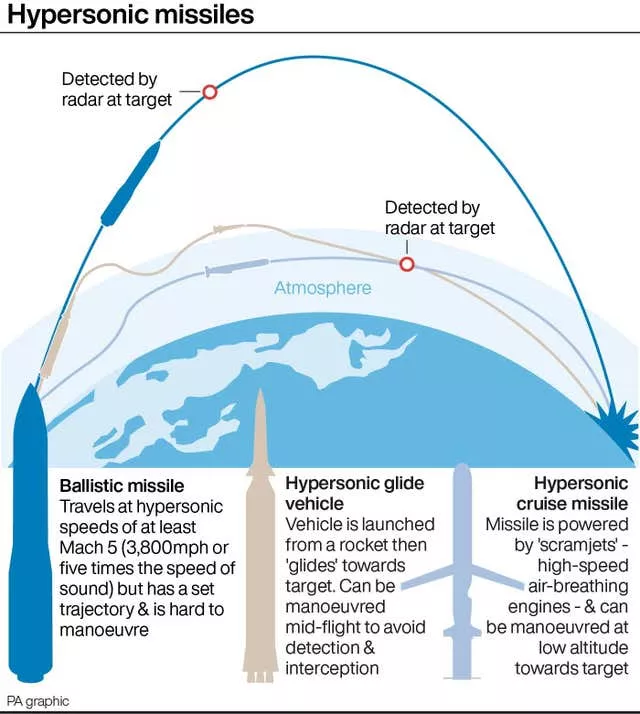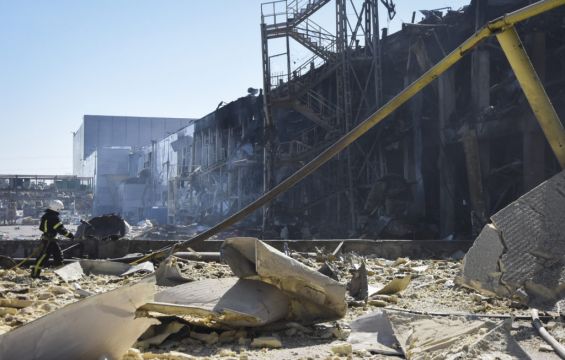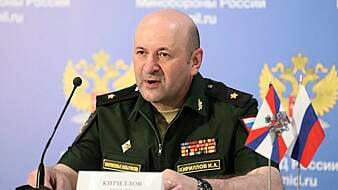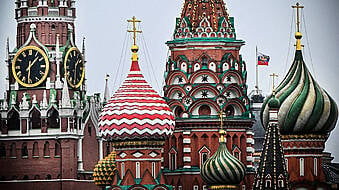Russian troops have been pounding the vital port of Odesa, Ukrainian officials said, apparently as part of efforts to disrupt the supply lines and weapons shipments that have been critical to Kyiv’s defence.
The Ukrainian military said Russian forces fired seven missiles on Monday from the air at Ukraine’s largest port, hitting a shopping centre and a warehouse. One person was killed and five wounded, the military said.
Images overnight showed a burning building and detritus in a heap of destruction in the city on the Black Sea. At daybreak, mayor Gennady Trukhanov visited the warehouse and said it “had nothing in common with military infrastructure or military objects”.

Ukraine alleged at least some of the munitions used dated back to the Soviet era, making them unreliable in targeting, but the Centre for Defence Strategies, a Ukrainian think tank tracking the war, said Moscow used some precision weapons including Kinzhal hypersonic air-to-surface missiles.
Ukrainian, British and American officials warn Moscow is rapidly using up its stock of precision weapons and may not be able to quickly build more, raising the risk of more imprecise rockets being used as the conflict grinds on.
Ukraine’s ability to fend off a larger and better armed Russian military has surprised many observers, who had anticipated a much quicker conflict.

With the war in its 11th week and Kyiv bogging Russian forces down in many places and even staging a counter-offensive in others, Ukraine’s foreign minister appeared to suggest the country could expand its aims beyond merely pushing Russia back to areas it or its allies held on the day of February 24 invasion.
One of the most dramatic examples of Ukraine’s ability to deny Moscow easy victories has been Mariupol, where Ukrainian fighters remain holed up at a steel plant despite a long siege.
The regiment defending the plant said on Tuesday that Russian war planes were still pounding it.
In recent days, the United Nations and Red Cross organised a dramatic rescue of what some officials said were the last civilians trapped at the plant, but on Tuesday, two officials said about 100 were believed to still be in the complex’s underground tunnels.

In another example of the grisly toll the war continues to take, the Ukrainians said they had found the bodies of 44 civilians in the rubble of a building in the north east that was destroyed weeks ago.
Ever since President Vladimir Putin’s forces failed to take Kyiv in the early days of the war, he has said his focus is the country’s eastern industrial heartland of the Donbas — but one general has suggested Moscow’s aims also include cutting Ukraine off from its Black Sea coast in the south.
That would also give it a stretch of territory that would link Russia to the Crimean peninsula, which it seized in 2014, and Transnistria, a pro-Russian breakaway region of Moldova.
Even if it falls short of severing Ukraine from the Black Sea — and it appears to lack the forces to do so — continuing missile strikes on Odesa reflect the city’s importance as a strategic transport hub.
The Russian military has repeatedly targeted the city’s airport and claimed that it has destroyed several batches of western weapons.

Odesa is also a major gateway for grain shipments, and Russia’s blockade is already threatening global food supplies.
Beyond that, the city is a cultural jewel, dear to Ukrainians and Russians alike, and targeting it carries symbolic significance as well.
In Mariupol, Russians also bombarded the Azovstal steel mill, the Azov regiment said, targeting the sprawling complex 34 times over the past 24 hours. Attempts to storm the plant also continued.
Petro Andryushchenko, an adviser to the city’s mayor, estimated that at least 100 civilians remained trapped the plant complex. Donetsk regional governor Pavlo Kyrylenko said they were people “that the Russians have not selected” for evacuation from a warren of tunnels and bunkers spread over four square miles.
With Russian forces struggling to gain ground in the Donbas, military analysts suggest that hitting Odesa might serve to stoke concern about south-western Ukraine, thus forcing Kyiv to station more forces there.

That would pull them away from the eastern front as its military stages counter-offensives near the city of Kharkiv, aiming to push the Russians back across the border.
Kharkiv and the surrounding area has been under sustained Russian attack since the beginning of the war in late February. In recent weeks, grisly pictures showed the horrors of those battles, with charred and mangled bodies strewn in one street.
Dozens of bodies have been found in a five-storey building that collapsed in March in Izyum, about 75 miles from Kharkiv, according to Oleh Synehubov, the head of the regional administration.
Ukraine’s foreign minister appeared to voice increasing confidence — and expanded goals — amid the stalled Russian offensive.
“In the first months of the war the victory for us looked like withdrawal of Russian forces to the positions they occupied before February 24 and payment for inflicted damage,” Dmytro Kuleba said in an interview with the Financial Times.
“Now if we are strong enough on the military front and we win the battle for Donbas, which will be crucial for the following dynamics of the war, of course the victory for us in this war will be the liberation of the rest of our territories.”







